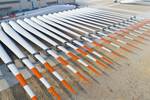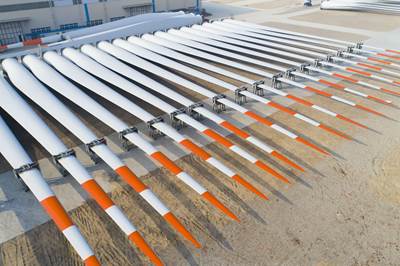U.K. develops Sustainable Composites to address composite recycling challenge
The partnership will accelerate new recycling technologies, such as delivering a series of R&D projects, investing in new material feedstocks and more.

Source | Sustainable Composites
Nadim Zawahi, MP of the U.K. Undersecretary of State for business, energy and industrial strategy, reported on July 3 at the University of Bristol’s Sustainability Summit that it has launched a new initiative called Sustainable Composites. Led by the National Composites Centre (NCC, Bristol, U.K.) and the Centre for Process Innovation (CPI, Wilton, U.K.), the initiative is designed to develop the next generation of sustainable composites by addressing the challenge of recycling composite materials. Zawahi says the partnership between industry, academia and government will harness the U.K.’s composites research and technology development capabilities to capitalize on the rapidly growing approximately £2 billion global market for end-of-life recycling.
The initiative notes that, out of the 110,000 MT of composites produced in the U.K. each year, only 15% of the materials are reused or recycled at the end of their life. Further, it notes that, while composites increase the lifespan of the products to which they are applied, the recycling process is difficult and current recycling techniques often degrade the material’s performance, reducing their value and offering limited applications.
Sustainable Composites is reportedly set to address these challenges by accelerating the development of new recycling technologies in the U.K., simultaneously creating new sustainable composites made from bio-based materials including vegetable waste, corn, nutshells and algae. The Sustainable Composites partnership also plans to deliver a series of R&D projects that bring together companies across the composites supply chain, from materials manufacturers, to chemical suppliers and recycling companies by investigating new material feedstocks (such as bio or waste) and developing product design and manufacturing processes to enable a quicker transition into the supply chain.
“Composites are already supporting sustainability and helping companies meet their low carbon goals.” says Ed Goodman, program lead for Sustainable Composites. “This initiative will harness our composites research and technology capabilities to make zero impact composites a reality. And it will ensure the U.K. continues to lead the way in sustainable materials and capitalize on the opportunities for recycling of valuable materials to protect our resources for future generations.”
Some projects the partnership will initiate include the “Steam to Value Stream” and “Bio-Bolster” project. The “Steam to Value Stream” project is said to be investigating how an innovative steam process developed and patented by SME B&M Longworth (Blackburn,U.K.) can be used to reclaim resin and fibers from a composite component. The team will then explore how these materials can be used in the HiPerDiF technology developed at the University of Bristol — a fiber realignment process that takes discontinuous short fibers and aligns them into ready-to-lay composite tapes to be used in aerospace, automotive and wind turbine manufacturing. The “Bio-Bolster” project is said to explore bio-derived resins for high volume manufacturing applications, and includes developing an understanding of supply chains, design requirements and performance characteristics to produce a material with less impact on the environment.
According to the report, the U.K. is already working toward technologies for composites recycling, including a technology that separates (or disbonds) composite structures quickly and cheaply using a heat source developed by the NCC and Oxford Brookes University (Oxford, U.K.). It will also assess a method to generate added value products from municipal solid waste, a work in progress by CPI and Fibreright (Pontypool, U.K.).
According to Zawahi, this initiative relies on the involvement of organizations from across industry to feed in ideas and shape future work. Companies that would like to get involved are invited to visit or email sustainable.composites@nccuk.com.
Related Content
Composites end markets: Sports and recreation (2025)
The use of composite materials in high-performance sporting goods continues to grow, with new advancements including thermoplastic and sustainability-focused materials and automated processes.
Read MoreScaling up thermoplastic composites recycling
Thermoplastic composites are always said to be “recyclable.” Netherlands-based recycler Spiral RTC discusses the process, challenges, applications and opportunities to building a real recycling ecosystem.
Read MoreJEC World 2024 highlights: Glass fiber recycling, biocomposites and more
CW technical editor Hannah Mason discusses trends seen at this year’s JEC World trade show, including sustainability-focused technologies and commitments, the Paris Olympics amongst other topics.
Read MoreDITF oriented rCF tapes target virgin fiber CFRP substitution
Infinity project developed highly oriented rCF/PA6 tapes with 88% the tensile strength, modulus of a virgin CFRP product and 49-66% reduction in global warming potential.
Read MoreRead Next
Wind energy leaders present recommendations for recycling wind turbine blades
The EuCIA, Cefic and WindEurope recently released a joint report aimed to accelerate wind turbine blade recycling efforts.
Read MoreCeramic matrix composites: Faster, cheaper, higher temperature
New players proliferate, increasing CMC materials and manufacturing capacity, novel processes and automation to meet demand for higher part volumes and performance.
Read MoreUltrasonic welding for in-space manufacturing of CFRTP
Agile Ultrasonics and NASA trial robotic-compatible carbon fiber-reinforced thermoplastic ultrasonic welding technology for space structures.
Read More












